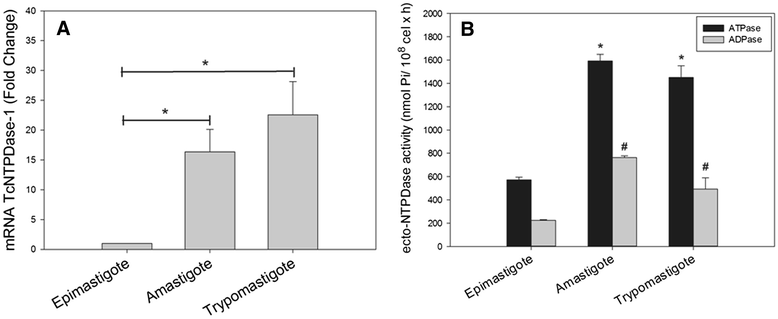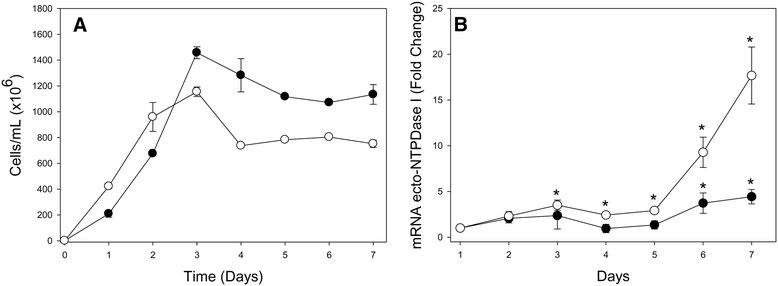Nucleoside triphosphate diphosphohydrolase1 (TcNTPDase-1) gene expression is increased due to heat shock and in infective forms of Trypanosoma cruzi
- PMID: 25287580
- PMCID: PMC4210531
- DOI: 10.1186/s13071-014-0463-0
Nucleoside triphosphate diphosphohydrolase1 (TcNTPDase-1) gene expression is increased due to heat shock and in infective forms of Trypanosoma cruzi
Abstract
Background: Ecto-Nucleoside Triphosphate Diphosphohydrolases (Ecto-NTPDases) are enzymes that hydrolyze tri- and/or di-phosphate nucleotides. Evidences point to their participation in Trypanosoma cruzi virulence and infectivity. In this work, we evaluate TcNTPDase-1 gene expression in comparison with ecto-NTPDase activity, in order to study the role of TcNTPDase-1 in parasite virulence, infectivity and adaptation to heat shock.
Findings: Comparison between distinct T. cruzi isolates (Y, 3663 and 4167 strains, and Dm28c, LL014 and CL-14 clones) showed that TcNTPDase-1 expression was 7.2 ± 1.5 times higher in the Dm28c than the CL-14 avirulent clone. A remarkable expression increase was also observed in the trypomastigote and amastigote forms (22.5 ± 5.6 and 16.3 ± 3.8 times higher than epimastigotes, respectively), indicating that TcNTPDase-1 is overexpressed in T. cruzi infective forms. Moreover, heat shock and long-term cultivation also induced a significant increment on TcNTPDase-1 expression.
Conclusions: Our results suggest that TcNTPDase-1 plays an important role on T. cruzi infectivity and adaptation to stress conditions, such as long-term cultivation and heat shock.
Figures



Similar articles
-
Knocking Down TcNTPDase-1 Gene Reduces in vitro Infectivity of Trypanosoma cruzi.Front Microbiol. 2020 Mar 18;11:434. doi: 10.3389/fmicb.2020.00434. eCollection 2020. Front Microbiol. 2020. PMID: 32256481 Free PMC article.
-
Trypanosoma cruzi: effects of heat shock on ecto-ATPase activity.Exp Parasitol. 2013 Apr;133(4):434-41. doi: 10.1016/j.exppara.2012.12.014. Epub 2013 Jan 4. Exp Parasitol. 2013. PMID: 23295384
-
Ectonucleotidases from trypomastigotes from different sources and various genetic backgrounds of Trypanosoma cruzi potentiate their infectivity and host inflammation.Cytokine. 2020 Dec;136:155255. doi: 10.1016/j.cyto.2020.155255. Epub 2020 Aug 28. Cytokine. 2020. PMID: 32866897
-
NTPDase activities: possible roles on Leishmania spp infectivity and virulence.Cell Biol Int. 2018 Jun;42(6):670-682. doi: 10.1002/cbin.10944. Epub 2018 Feb 19. Cell Biol Int. 2018. PMID: 29384228 Review.
-
E-NTPDases: Possible Roles on Host-Parasite Interactions and Therapeutic Opportunities.Front Cell Infect Microbiol. 2021 Nov 9;11:769922. doi: 10.3389/fcimb.2021.769922. eCollection 2021. Front Cell Infect Microbiol. 2021. PMID: 34858878 Free PMC article. Review.
Cited by
-
Knocking Down TcNTPDase-1 Gene Reduces in vitro Infectivity of Trypanosoma cruzi.Front Microbiol. 2020 Mar 18;11:434. doi: 10.3389/fmicb.2020.00434. eCollection 2020. Front Microbiol. 2020. PMID: 32256481 Free PMC article.
-
Overexpression of TcNTPDase-1 Gene Increases Infectivity in Mice Infected with Trypanosoma cruzi.Int J Mol Sci. 2022 Nov 24;23(23):14661. doi: 10.3390/ijms232314661. Int J Mol Sci. 2022. PMID: 36498985 Free PMC article.
-
RNA as a feasible marker of Trypanosoma cruzi viability during the parasite interaction with the triatomine vector Rhodnius prolixus (Hemiptera, Triatominae).PLoS Negl Trop Dis. 2022 Jul 7;16(7):e0010535. doi: 10.1371/journal.pntd.0010535. eCollection 2022 Jul. PLoS Negl Trop Dis. 2022. PMID: 35797352 Free PMC article.
-
Synthesis of new non-natural L-glycosidic flavonoid derivatives and their evaluation as inhibitors of Trypanosoma cruzi ecto-nucleoside triphosphate diphosphohydrolase 1 (TcNTPDase1).Purinergic Signal. 2024 Aug;20(4):399-419. doi: 10.1007/s11302-023-09974-7. Epub 2023 Nov 17. Purinergic Signal. 2024. PMID: 37975950 Free PMC article.
References
-
- Zingales B, Andrade SG, Briones MRS, Campbell DA, Chiari E, Fernandes O, Guhl F, Lages-Silva E, Macedo AM, Machado CR, Miles MA, Romanha AJ, Sturm NR, Tibayrenc M, Schijman AG. A new consensus for Trypanosoma cruzi intraspecific nomenclature: second revision meeting recommends TcI to TcVI. Mem Inst Oswaldo Cruz. 2009;104:1051–1054. doi: 10.1590/S0074-02762009000700021. - DOI - PubMed
-
- Santana RA, Magalhães LK, Magalhães LK, Prestes SR, Maciel MG, da Silva GA, Monteiro WM, de Brito FR, de Aguiar Raposo Câmara Coelho LI, Barbosa-Ferreira JM, Guerra JA, Silveira H, Das Graças Vale Barbosa M. Trypanosoma cruzi strain TcI is associated with chronic Chagas disease in the Brazilian Amazon. Parasit Vectors. 2014;7(1):267. doi: 10.1186/1756-3305-7-267. - DOI - PMC - PubMed
Publication types
MeSH terms
Substances
LinkOut - more resources
Full Text Sources
Other Literature Sources

